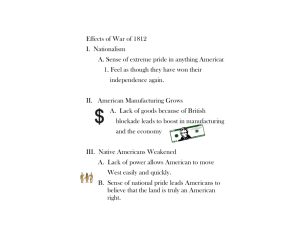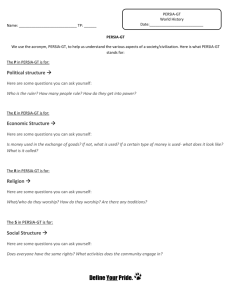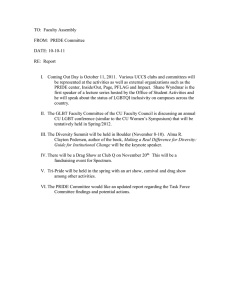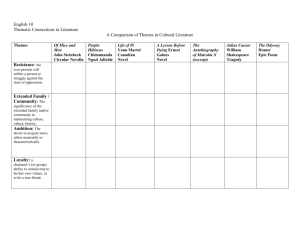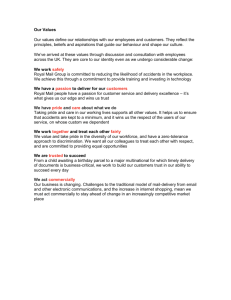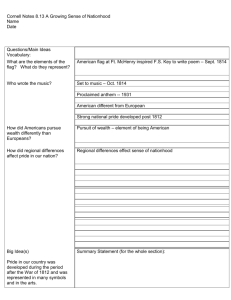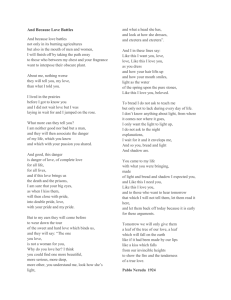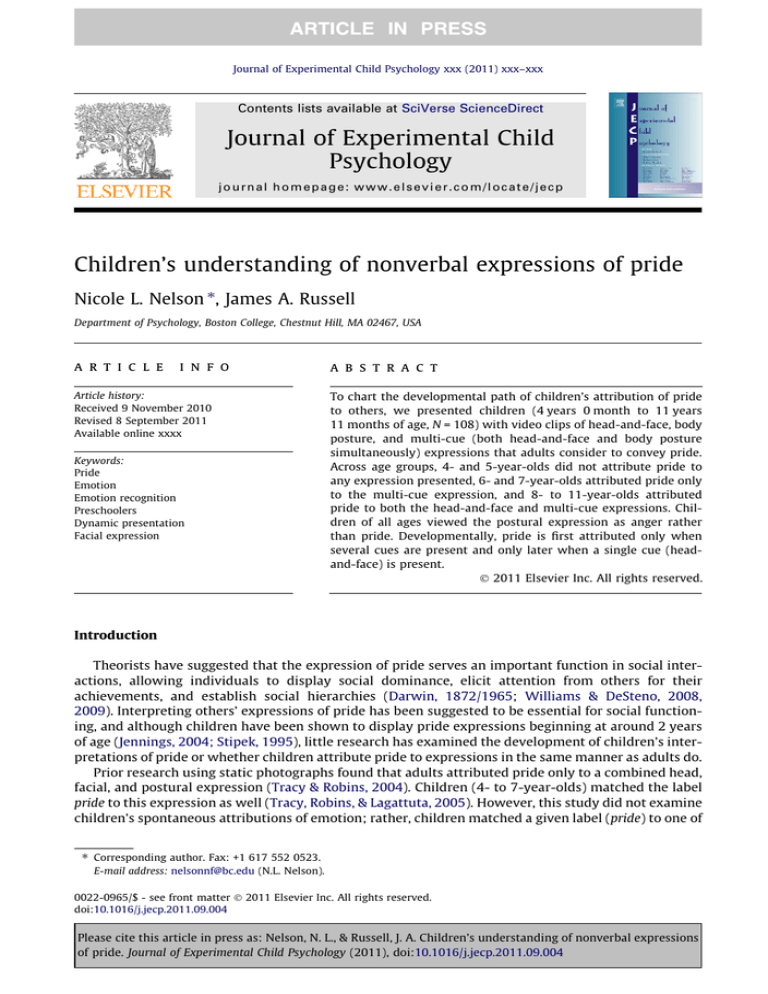
Journal of Experimental Child Psychology xxx (2011) xxx–xxx
Contents lists available at SciVerse ScienceDirect
Journal of Experimental Child
Psychology
journal homepage: www.elsevier.com/locate/jecp
Children’s understanding of nonverbal expressions of pride
Nicole L. Nelson ⇑, James A. Russell
Department of Psychology, Boston College, Chestnut Hill, MA 02467, USA
a r t i c l e
i n f o
Article history:
Received 9 November 2010
Revised 8 September 2011
Available online xxxx
Keywords:
Pride
Emotion
Emotion recognition
Preschoolers
Dynamic presentation
Facial expression
a b s t r a c t
To chart the developmental path of children’s attribution of pride
to others, we presented children (4 years 0 month to 11 years
11 months of age, N = 108) with video clips of head-and-face, body
posture, and multi-cue (both head-and-face and body posture
simultaneously) expressions that adults consider to convey pride.
Across age groups, 4- and 5-year-olds did not attribute pride to
any expression presented, 6- and 7-year-olds attributed pride only
to the multi-cue expression, and 8- to 11-year-olds attributed
pride to both the head-and-face and multi-cue expressions. Children of all ages viewed the postural expression as anger rather
than pride. Developmentally, pride is first attributed only when
several cues are present and only later when a single cue (headand-face) is present.
Ó 2011 Elsevier Inc. All rights reserved.
Introduction
Theorists have suggested that the expression of pride serves an important function in social interactions, allowing individuals to display social dominance, elicit attention from others for their
achievements, and establish social hierarchies (Darwin, 1872/1965; Williams & DeSteno, 2008,
2009). Interpreting others’ expressions of pride has been suggested to be essential for social functioning, and although children have been shown to display pride expressions beginning at around 2 years
of age (Jennings, 2004; Stipek, 1995), little research has examined the development of children’s interpretations of pride or whether children attribute pride to expressions in the same manner as adults do.
Prior research using static photographs found that adults attributed pride only to a combined head,
facial, and postural expression (Tracy & Robins, 2004). Children (4- to 7-year-olds) matched the label
pride to this expression as well (Tracy, Robins, & Lagattuta, 2005). However, this study did not examine
children’s spontaneous attributions of emotion; rather, children matched a given label (pride) to one of
⇑ Corresponding author. Fax: +1 617 552 0523.
E-mail address: nelsonnf@bc.edu (N.L. Nelson).
0022-0965/$ - see front matter Ó 2011 Elsevier Inc. All rights reserved.
doi:10.1016/j.jecp.2011.09.004
Please cite this article in press as: Nelson, N. L., & Russell, J. A. Children’s understanding of nonverbal expressions
of pride. Journal of Experimental Child Psychology (2011), doi:10.1016/j.jecp.2011.09.004
2
N.L. Nelson, J.A. Russell / Journal of Experimental Child Psychology xxx (2011) xxx–xxx
three presented photographs (depicting pride, happiness, or surprise) and only the pride expression
contained postural components. Children’s attribution of pride to the expression was low
(mean = 59%, where random responding would be 33%), and even this low percentage may have been
inflated by the uneven presentation of postural expressions across photographs (Tracy et al., 2005)
and by the forced-choice method used (Russell, 1993). This prior research leaves open the question
of how children spontaneously interpret expressions of pride (i.e., without labels provided), information necessary to determine how children’s daily interpretations of complex social interactions and
expressions develop and when these interpretations come to resemble those of adults.
It is possible that children’s attribution of pride to a display will be greater when more information
is provided. For example, the static photographs commonly used omit information contained in the
dynamic expressions children see in daily interactions. And indeed, adults are more likely to attribute
the expected emotion to a dynamic display than to a static one (Ambadar, Schooler, & Cohn, 2005;
Bould, Morris, & Wink, 2008; Wehrle, Kaiser, Schmidt, & Scherer, 2000). In addition, adults attribute
pride to a dynamic head and facial expression alone even when postural information is not included
(Nelson & Russell, 2011b); perhaps with the presentation of dynamic stimuli, children will also find a
head and facial expression to be sufficient for attribution of pride.
To chart the developmental course of children’s attributions of pride based on nonverbal cues, we
presented 4- to 11-year-olds with expressive components previously associated with pride. We asked
a professional female actor to create a dynamic pride expression in which facial and postural cues
were presented simultaneously in an intense but realistic display. She also created displays of happiness, fear, surprise, disgust, and embarrassment, all of which included head, facial, and postural cues
(for details, see Nelson & Russell, in preparation, 2011a). For each emotion, we created 5-s video clips
for three conditions: Head-and-Face-only, Body Posture-only, and Multi-cue (both head-and-face and
body posture). In a within-participant design, we showed children all six emotions in each of the three
conditions for a total of 18 trials.
Method
Participants
Participants were 108 children, with 36 children in each of three age groups: 4- and 5-year-olds
(M = 55 months, SD = 4.5), 6- and 7-year-olds (M = 80 months, SD = 10.0), and 8- to 11-year-olds
(M = 117 months, SD = 14.8). Each age group included an equal number of males and females. All children were fluent in English and tested at child care centers in the greater Boston area or at the Boston
Museum of Science.
Materials
The video clips were of an approximate standard length (5 s) and featured a professional female
actor who had more than 10 years of acting experience in theater and film. Although no sound was
presented, the actor said the same neutral sentence in each of the video clips (‘‘I felt this feeling before; it was just a few days ago’’).
The cues to pride that the actor performed were modeled after previously suggested information
concerning the expression of pride (Darwin, 1872/1965) and expressions used in previous research
(Tracy & Robins, 2004, 2008). In addition, the actor relied on her expertise and experience in acting
to ensure that the entire expression was realistic.
Head-and-Face-only video clip
This expression included a slightly tilted head and a small smile, as described in previous research
(Nelson & Russell, 2011b; Tracy & Robins, 2004). Only the actor’s head and neck were visible, and the
actor moved from a neutral expression to an emotional expression while speaking (no sound was
presented).
Please cite this article in press as: Nelson, N. L., & Russell, J. A. Children’s understanding of nonverbal expressions
of pride. Journal of Experimental Child Psychology (2011), doi:10.1016/j.jecp.2011.09.004
N.L. Nelson, J.A. Russell / Journal of Experimental Child Psychology xxx (2011) xxx–xxx
3
Body Posture-only video clip
This expression included the actor’s head and body, but her face was obscured with a Gaussian blur
throughout the clip. The actor was standing and moved from a neutral posture to an expanded emotional posture (which she maintained throughout the expression). Two postures have been associated
with pride in previous research, arms akimbo and arms raised over the head (Tracy & Robins, 2004,
2008), and the actress displayed both of these postures, first placing her arms akimbo and then raising
her arms over her head.
Multi-cue video clip
The actor simultaneously displayed the head and facial expression (moving from a neutral face to
an emotional face) and body posture (moving from a standing neutral posture to an expanded emotional posture). The cues used in the Multi-cue clip were identical to those used in the other clips.
Manipulation check
In prior research (Nelson & Russell, 2011b), the facial expression presented was coded using the
Facial Action Coding System (Ekman & Friesen, 1978) to ensure that the expression included the suggested facial components, and the postural expression was verified using the Pride Nonverbal Coding
Scheme (Tracy & Robins, 2008) to ensure that the postural expressions included the suggested head,
arm, and body components used in prior studies.
Procedure
Priming
Children first underwent a priming procedure to make the needed emotion terms as accessible as
possible. The experimenter initiated a conversation with the children about feelings, asking questions
such as: ‘‘Happiness is a feeling; have you ever felt happy?’’ The labels targeted in the priming session
were those that were to be presented in the study (pride, happiness, fear, surprise, disgust, and embarrassment), and all children who participated in the study heard each target emotion label twice before
participating.
Introductory video clips
Children in the two youngest age groups (4- and 5-year-olds and 6- and 7-year-olds) were first
shown three introductory video clips of the actor performing normal daily activities in her house
but displaying no emotion. Children were asked to label an easily recognizable household object held
by the actor in the video clip (book, apple, or hat) to ensure that they were able to produce labels in
reference to the video clips when prompted. All children in these age groups correctly labeled the objects presented.
Target trials
The video clips were presented as three separate blocks of trials (Head-and-Face-only, Body Posture-only, and Multi-cue), and all six emotions were presented within each block.1 The emotions within each block of video clips were ordered using a Latin square design. Head-and-Face-only and Body
Posture-only were presented first, in counterbalanced order; the Multi-cue block was always presented
last.
Children were introduced to each block of trials by the experimenter, who gave a general verbal
description of the block: ‘‘Molly is going to show us how she feels. But in these videos, we will see
her face [body or face and body]. So, we can watch her face [body or face and body] to see how she
feels.’’ The video clip was then played, and the actor displayed an emotional expression. Children were
asked to answer the question ‘‘How did she feel?’’ and were free to give any emotion label they chose.
1
Findings concerning children’s labeling of the nontarget emotions in the study (happiness, fear, surprise, disgust, and
embarrassment) are available from the authors on request.
Please cite this article in press as: Nelson, N. L., & Russell, J. A. Children’s understanding of nonverbal expressions
of pride. Journal of Experimental Child Psychology (2011), doi:10.1016/j.jecp.2011.09.004
4
N.L. Nelson, J.A. Russell / Journal of Experimental Child Psychology xxx (2011) xxx–xxx
Percentage attributing pride
100
90
80
70
60
Multi-cue
50
40
Head-and-
30
Face-only
20
Body
10
Posture-only
0
4- and 5year-olds
6- and 7year-olds
8- to 11year-olds
Adults
Fig. 1. Percentages of children attributing pride to pride clips. Children’s performance is compared with adults’ performance in
prior research (Nelson & Russell, 2011b). Percentage Attributing Pride
We chose this free-labeling format over a forced-choice format to examine participants’ spontaneous
rather than forced interpretations of cues.
Scoring
Children used a variety of labels to describe the emotions shown (e.g., joyful, frustrated, afraid,
grossed out). Three independent judges, blind to the stimulus condition, sorted the labels into one
of eight categories: happiness, sadness, anger, fear, surprise, disgust, embarrassment, and pride. Labels
placed in the same category by two of the three judges were scored as correct for that category. Labels
for which judges could not come to an agreement were categorized as ‘‘other.’’ For the category of
pride, two labels were scored as correct: proud and confident. All other labels used were categorized
into one of the other categories listed.
Results and discussion
Effect of cue type
A one-way repeated-measures analysis of variance (ANOVA) examining children’s labeling of the
pride clips showed that, as expected, children’s likelihood of attributing pride to the clips increased
with age, F(2, 105) = 9.28, p < .001, partial g2 = .38. Least significant difference (LSD) post hoc tests
indicated that 8- to 11-year-olds2 were most likely to attribute pride to the clips presented (percentage
attributing pride = 62%), followed by 6- and 7-year-olds (40%) and 4- and 5-year-olds (4%) (all ps < .001).
Children’s performance also varied with the cue presented, F(2, 210) = 2.42, p < .001, partial g2 = .22.
Children attributed pride to the Multi-cue clip (48%) significantly more often than the Head-and-Faceonly (37%) and Body Posture-only (18%) expressions (all ps < .004). These results indicate that, overall,
children were more likely to attribute pride to an expression with combined facial and postural cues than
to a single cue.
Of particular interest to this study, the effect of cue was qualified by a Cue Age interaction, F(4,
210) = 8.33, p < .001, partial g2 = .14 (Fig. 1). The 4- and 5-year-olds were unlikely to attribute pride to
any of the cues (range of percentages attributing pride: 0–5%); this was likely due to a floor effect, suggesting that preschool-aged children do not spontaneously attribute pride to any expression presented. LSD post hoc tests indicated that the 6- and 7-year-olds were more likely to attribute pride
2
A repeated-measures ANOVA showed no effect of age on the performance of 8- to 11-year-olds, F(3, 32) = 2.33, p = .09, so these
children were grouped together as a single age group.
Please cite this article in press as: Nelson, N. L., & Russell, J. A. Children’s understanding of nonverbal expressions
of pride. Journal of Experimental Child Psychology (2011), doi:10.1016/j.jecp.2011.09.004
5
N.L. Nelson, J.A. Russell / Journal of Experimental Child Psychology xxx (2011) xxx–xxx
Table 1
Percentage of labels from each category given for each cue type for pride.
Label used
Head-and-Face-only
Body Posture-only
Multi-cue
Mean
Pride
Happiness
Anger
Surprise
Other
Total
47
47
1
3
2
100
27
9
52
2
10
100
52
38
4
1
5
100
42
31
19
2
6
Note: N = 108. Maximum = 100. The modal response for each cue is given in bold.
to the Multi-cue clip than to either the Head-and-Face-only or Body Posture-only clips (all ps < .001), a
pattern that replicates prior findings with children presented with static photographs (Tracy et al.,
2005). In addition, 6- and 7-year-olds were as likely to attribute pride to the Head-and-Face-only
expression as they were to the Body Posture-only expression, suggesting that these cues conveyed
pride equally well to children of this age, although not as well as a combined facial and postural
expression. However, the 8- to 11-year-olds showed an adult-like pattern; they were as likely to attribute pride to the Head-and-Face-only expression as they were to the Multi-cue expression. The 8- to
11-year-olds were less likely than adults to attribute pride to the Body Posture-only expression; their
performance was similar to that of the 6- and 7-year-olds, suggesting that 8- to 11-year-olds showed a
greater increase in attributing pride to the Head-and-Face-only expression than to the Body Postureonly expression. Overall, 8- to 11-year-olds showed a response pattern similar to that found in prior
research with adults; adults were equally likely to attribute pride to the Head-and-Face-only and Multi-cue expressions and less likely to attribute pride to the Body Posture-only expression (Nelson & Russell, 2011b).
Terms used to label pride components
Across the three pride clips, 58% of children’s responses were other than pride (Table 1). For the
Multi-cue clip, children’s modal response was pride (52%), followed by happiness (38%). However,
for the Head-and-Face-only expression, children’s responses were equally divided between happiness
(47%) and pride (47%). Finally, as has been found with adults (Nelson & Russell, 2011b), children’s
modal response for the Body Posture-only expression was anger (52%). These results suggest that, like
adults, children interpret the Head-and-Face-only and Multi-cue expressions as expressing positive
emotions (either pride or happiness), but the Body Posture-only expression is interpreted as displaying anger. The emotion of pride is often considered to be positive in valence, but these results indicate
that it is the facial component of this expression that prompts children to interpret the display as positive; when the facial expression is absent, they are more likely to interpret the display as negative.
Conclusion
These results provide the first evidence of the development shift in children’s attributions of pride
to expression components. Preschool-aged children do not spontaneously attribute pride to expressions but rather attribute happiness to the Head-and-Face-only and Multi-cue expressions. However,
6- and 7-year-olds attribute pride to an expression that contains both facial and postural cues but do
not attribute pride to these cues individually. Finally, children 8 years of age and older, like adults,
attribute pride to the face alone and do not find an additional benefit when presented with an expression that contains facial and postural cues to pride. Children’s understanding of pride expressions appears to develop beyond elementary school, however, given that 8- to 11-year-olds’ attributions of
pride to the Body Posture-only clip had yet to reach adult-like levels.
That preschoolers did not attribute pride to the expressions presented is a finding in contrast to
existing research using static photographs in which preschoolers matched a pride expression with a
label (proud) given by the experimenter (Tracy et al., 2005). Two possibilities arise that could explain
Please cite this article in press as: Nelson, N. L., & Russell, J. A. Children’s understanding of nonverbal expressions
of pride. Journal of Experimental Child Psychology (2011), doi:10.1016/j.jecp.2011.09.004
6
N.L. Nelson, J.A. Russell / Journal of Experimental Child Psychology xxx (2011) xxx–xxx
this difference. One possibility is that preschoolers are less likely to attribute the expected emotion to
a facial and postural expression that is dynamic than to one that is static. However, previous research
has shown that preschoolers’ labeling of emotions is unaffected by whether the stimuli are static or
dynamic (Nelson & Russell, 2011c), making this suggestion unlikely. A second explanation is that preschoolers’ apparent ability to recognize pride in prior research was due to the forced-choice method
used. Preschoolers may have attributed pride to the expression only because the word was provided
by the experimenter; the results of this study show that their spontaneous interpretations of the
expression follow a different pattern. It is possible that prior findings reflect preschoolers’ likelihood
of matching the label pride to an expression, whereas the results of this study reflect preschoolers’
spontaneous interpretations of an expression, as would happen in everyday life.
Although 8- to 11-year-olds showed adult-like response patterns for the Head-and-Face-only and
Multi-cue clips, their attributions of pride to the Body Posture-only clip were lower than those of
adults in prior research (Nelson & Russell, 2011b). This suggests that children first reach adult-like
proficiency in attributing pride to expressions containing a facial expression (Head-and-Face-only
and Multi-cue), and understanding of postural expressions continues to develop after 11 years of age.
Children interpreted the postural components associated with pride as conveying negative emotion (anger) when presented alone, but when presented with a facial expression (i.e., the Multi-cue
clip) they interpreted the overall expression as positive (pride or happiness). These results suggest
that it is the facial component of the pride expression that conveys positive emotion, supporting prior
research with adults (Nelson & Russell, 2011b). Adults have been shown to view pride expressions as
displaying both ‘‘pride’’ and ‘‘determination’’ (historically considered a negative emotion [Schlosberg,
1954]) (Harmon-Jones, Schmeichel, Mennitt, & Harmon-Jones, 2011) and interpret the postural component of pride as highly dominant (Snyder, App, & McIntosh, 2011). It is possible that children in this
study interpreted the postural display as ‘‘dominant’’ or ‘‘determined’’ and, therefore, attributed a negative aggressive emotion to the display: anger.
This research raises broader questions concerning children’s everyday social interactions in which
pride is expressed. It is possible that preschool-aged children are entirely unable to spontaneously
attribute pride to others, but an equally likely possibility is that another stimulus would prove to
be a better cue for these children (e.g., stories about events that evoke pride or other facial expressions). Children have been shown to attribute emotions in an adult-like manner to stories at younger
ages than they do to facial expressions (Balconi & Carrera, 2007; Reichenbach & Masters, 1983; Widen
& Russell, 2010), and prior research has shown this to be the case for pride as well (Nelson, Hudspeth,
& Russell, 2011). It is possible that preschoolers first understand pride in terms of events and only later
match these events to expressions. In addition, children’s increased likelihood of attributing pride to
the components presented in this study may simply be due to cognitive maturation but may also be
related to their increased experiences with school-aged peers seeking to establish social hierarchies,
resulting in an increased sensitivity to pride expressions. The recognition of pride has been suggested
to be essential for successfully navigating complex social interactions, and this research illustrates the
complex and multifaceted developmental processes that occur as children come to view these expressions in the same way as adults do.
Acknowledgments
This research was supported by Grant 0421702 from the National Science Foundation awarded to
James A. Russell. We thank Thalia Goldstein, Darren Herlihy, Scott Limanek, and Rich Howley for their
help in constructing the stimuli for this project and also thank Sherri Widen, Mary Kayaal, and Matt
Williams for their assistance in conducting the study as well as all of the parents, children, and care
centers who agreed to participate in this research.
References
Ambadar, Z., Schooler, J. W., & Cohn, J. F. (2005). Deciphering the enigmatic face. The importance of facial dynamics in
interpreting subtle facial expressions. Psychological Science, 16, 403–410.
Please cite this article in press as: Nelson, N. L., & Russell, J. A. Children’s understanding of nonverbal expressions
of pride. Journal of Experimental Child Psychology (2011), doi:10.1016/j.jecp.2011.09.004
N.L. Nelson, J.A. Russell / Journal of Experimental Child Psychology xxx (2011) xxx–xxx
7
Balconi, M., & Carrera, A. (2007). Emotional representation in facial expression and script: A comparison between normal and
autistic children. Research in Developmental Disabilities, 28, 409–422.
Bould, E., Morris, N., & Wink, B. (2008). Recognising subtle emotional expressions: The role of facial movements. Cognition and
Emotion, 22, 1569–1587.
Darwin, C. (1965). The expression of the emotions in man and animals. Chicago: University of Chicago Press (Original work
published 1872).
Ekman, P., & Friesen, W. V. (1978). Manual of the Facial Action Coding System (FACS). Palo Alto, CA: Consulting Psychologists Press.
Harmon-Jones, C., Schmeichel, B. J., Mennitt, E., & Harmon-Jones, E. (2011). The expression of determination: Similarities
between anger and approach-related positive affect. Journal of Personality and Social Psychology, 199, 172–181.
Jennings, K. D. (2004). Development of goal-directed behaviour and related self-processes in toddlers. International Journal of
Behavioral Development, 28, 319–327.
Nelson, N. L., Hudspeth, K., & Russell, J. A. (2011). Story, still face, or dynamic expression: Which is the best cue to emotion for
children? (unpublished manuscript), Boston College.
Nelson, N. L., & Russell, J. A. (in preparation). Children’s use of emotion expression components for basic and social emotions, Boston
College.
Nelson, N. L., & Russell, J. A. (2011a). Preschoolers’ use of dynamic facial, bodily, and vocal cues to emotion. Journal of
Experimental Child Psychology, 1, 52–61.
Nelson, N. L., & Russell, J. A. (2011b). When dynamic, the head and face alone can express pride. Emotion, 4, 990–993.
Nelson, N. L., & Russell, J. A. (2011c). Putting motion in emotion: Do dynamic presentations increase preschoolers’ recognition of
emotion? Cognitive Development, 26, 248–259.
Reichenbach, L., & Masters, J. C. (1983). Children’s use of expressive and contextual cues in judgments of emotion. Child
Development, 54, 993–1004.
Russell, J. A. (1993). Forced-choice response format in the study of facial expression. Motivation and Emotion, 17, 41–51.
Schlosberg, H. (1954). Three dimensions of emotion. Psychological Review, 61, 81–88.
Snyder, S. A., App, B. L., & McIntosh, D. N. (2011). Body posture, not facial expression, conveys status in pride displays. San Antonio,
TX: Poster presented at the Sixth Annual Emotion Preconference for the Society for Personality and Social Psychology.
Stipek, D. (1995). The development of pride and shame in toddlers. In J. P. Tangney & K. W. Fischer (Eds.), Self-conscious emotions
(pp. 237–252). New York: Guilford.
Tracy, J. L., & Robins, R. W. (2004). Show your pride: Evidence for a discrete emotion expression. Psychological Science, 15,
194–197.
Tracy, J. L., & Robins, R. W. (2008). The automaticity of emotion recognition. Emotion, 8, 81–95.
Tracy, J. L., Robins, R. W., & Lagattuta, K. H. (2005). Can children recognize the pride expression? Emotion, 5, 251–257.
Wehrle, T., Kaiser, S., Schmidt, S., & Scherer, K. R. (2000). Studying the dynamics of emotional expression using synthesized facial
muscle movements. Journal of Personality and Social Psychology, 78, 105–119.
Widen, S. C., & Russell, J. A. (2010). Children’s scripts for social emotions: Causes and consequences are more central than are
facial expressions. British Journal of Developmental Psychology, 28, 565–581.
Williams, L. A., & DeSteno, D. (2008). Pride and perseverance. The motivational role of pride. Journal of Personality and Social
Psychology, 94, 1007–1017.
Williams, L. A., & DeSteno, D. (2009). Pride: Adaptive social emotion or seventh sin? Psychological Science, 20, 284–288.
Please cite this article in press as: Nelson, N. L., & Russell, J. A. Children’s understanding of nonverbal expressions
of pride. Journal of Experimental Child Psychology (2011), doi:10.1016/j.jecp.2011.09.004

